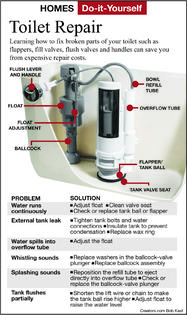Here's How: Many Simple Repairs for Toilets
Dear James: My house has two and a half bathrooms and each of the toilets has problems such as inadequate flushing, noisy flushing and self-flushing. Does it require a plumber to fix them? -- Stephanie L.
Dear Stephanie: Some repair projects require a plumber, but most common toilet problems can easily be repaired by the homeowner. There are literally hundreds of replacements parts and repair kits readily available for virtually every type of residential toilet. You will need some open-end wrenches.
It is important to understand how a toilet works in order to diagnose the problem and plan a fix. Most of the water in the toilet tank runs down inside the back of the toilet, not into the bowl. This creates suction in the drain side and the water and waste are sucked out of the bowl and down the drain.
The water that you see flowing in the toilet bowl is from the flush jet and the rim holes. The flush jet fills the channel with water so that the suction can be created. The rim holes allow just enough water into the bowl to wash off the surfaces as it flushes the waste down the drain.
Your first problem of an inadequate flush can have many causes. A clog in the main drain pipe, especially if you have young children and small toys, is the most likely cause. Most hardware stores sell toilet augers to clean out the drain.
Depending on the brand of toilet that you have and its internal design, you may have to work a while to get the auger to snake through the water passages. Sometimes bending the hook on the end one direction or the other can make it snake in much easier. It is just a process of trial and error.
If there is still a flushing problem after the drain is cleaned, check the flush jet, which is usually at the bottom of the bowl. It can become so clogged with hard water deposits that the water seal is not always created when the toilet is flushed. Without the seal, the water is not sucked out and down the drain but instead just swirls around in the bowl.
If you see swirling, pour a large bucket of water quickly into the toilet bowl. This will usually cause it to flush out the bowl and leave it fairly empty. Use a sponge to remove the rest of the water. Scrape any hard water deposits out of the flush jet with a wooden stick or spoon.
Pour some white vinegar or muriatic acid into the overflow pipe in the tank and into the bowl so that it flows into the flush jet. If you use the acid and you hear a fizzing sound, you know that it is reacting with the hard water deposits. Muriatic acid will not harm the toilet materials.
A noisy toilet -- often presenting as a whistling sound just before the tank is full -- is usually caused by an older style ballcock valve in the tank. As it nears its final closed position, it slowly shuts off the water, creating the noise. Replace it with a newer design with a vertical float that goes from full flow to off much more quickly.
Your mysterious self-flushing toilet probably has a bad flapper valve at the bottom of the tank. This allows a slight amount of water to leak out. After about five or ten minutes, the ballcock float drops low enough that the water comes on again to fill the tank.
You can easily test for this by putting a few drops of red food coloring into the tank. If you see a red tint in the bowl a few minutes later, you will have to replace the inexpensive flapper valve in the tank.
========
Send your questions to Here's How, 6906 Royalgreen Dr., Cincinnati, Ohio, 45244 or visit www.dulley.com. To find out more about James Dulley and read features by other Creators Syndicate writers and cartoonists, visit the Creators Syndicate website at www.creators.com.
Copyright 2024 Creators Syndicate Inc.






























Comments